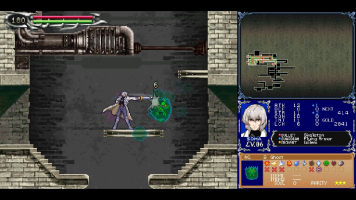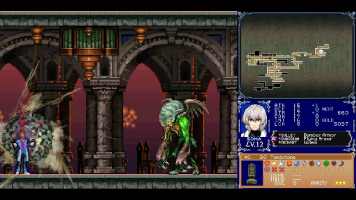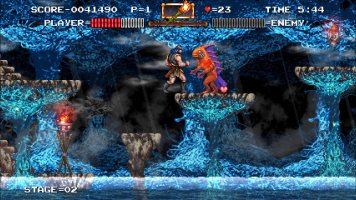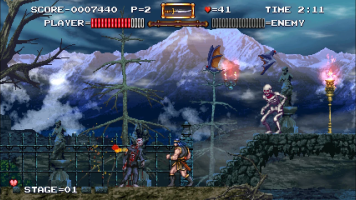Official Review
Despite this, the publisher has been trickling out compilations of its older Castlevania games, starting with the Anniversary Collection in 2019 followed by the Advance Collection in 2021. Now, Castlevania Dominus Collection brings all three DS entries to the Switch in one handy package, meaning fans now have access to pretty much every Castlevania game worth playing on one system. Right..? Right? Sigh… C'mon, Konami, just give us Symphony of the Night, for goodness' sake.
The three games included here (well, five actually, but more on that later) carry on the same 'Igavania' approach seen in the earlier GBA titles. Time is a funny thing, because back in 2008 when Order of Ecclesia launched, there was a general feeling that the style of gameplay popularized by Symphony of the Night in 1997 was beginning to feel somewhat stale (which, we imagine, is partly why Konami pivoted to the more action-oriented Lords of Shadow saga).
Now, 16 years later, we can confidently state that Dawn of Sorrow, Portrait of Ruin, and Order of Ecclesia represent the franchise at its absolute peak. Aria of Sorrow and Symphony of the Night may well be held in higher regard, but gosh, we were eating good during the DS era.
Each game plays wonderfully well on the Switch, too. Dawn of Sorrow, the earliest of the three, tried to take advantage of the touchscreen functionality without relying on it too heavily; quite successfully too, we might add. These mechanics, like the 'Magic Seal' system and destroying certain blocks in the in-game world, can be executed on Switch by either touching the screen directly in handheld mode or by holding down 'ZR' and moving the right analogue stick. The former is easily our preferred method, but both are valid options. We should point out too that if you're pondering which system to purchase Dominus Collection for, you can't very well use a touchscreen on PS5 or Xbox, can you? Something to consider.
Portrait of Ruin dials back the touchscreen controls considerably, but it mixes up the gameplay by adding in an additional character. You can swap between the two at the drop of a hat, call upon your ally to assist in puzzle-solving, and more. It's a neat little experiment and we love how seamless the mechanics are; there's simply no delay in switching between Jonathan and Charlotte. Overall, the game doesn't quite reach the same heights as Dawn of Sorrow, however, largely thanks to some iffy environmental and enemy design. Still, it's a title that remains one of the most unique entries in the entire franchise to this day.
Finally, Order of Ecclesia probably sits somewhere in between Dawn of Sorrow and Portrait of Ruin in terms of sheer quality. The gameplay here is sublime, focusing entirely on the new Glyph system in which you gain new items and abilities via Glyphs obtained within the game world and after defeating enemies. It's a challenging entry and also one of the most unique in the series, though one that does admittedly take a little while to find its footing. Many of the earlier environments in particular are completely linear since the game attempted to broaden its horizons across several locales. It's an ambitious change from the norm, but many of the locations are limited to just straight corridors crammed full of enemies. Not great, but the experience definitely improves as you progress.
Unlike the Advance Collection, the three games included here don't support the ability to alter their visuals via filters or smoothing. Honestly, they look spectacular as they are, so we weren't too fussed about this omission. In fact, we'd go so far as to say they look significantly better than the originals, particularly when it comes to environmental detail.
What you can do, however, is rearrange the display to your liking. By default, the main display is on the left, the map is on the top right, and further information such as enemies and stats are bottom right. You can fiddle with this to make certain screens bigger or smaller, and you can even replicate the classic DS layout. This admittedly doesn't look great in handheld mode as everything gets pretty dinky, but it's a fine option for a bigger TV display. Much like the Advance Collection, you've also got save states and a handy rewind function accessed via a dedicated menu independent of the games themselves. Lovely stuff.
Of course, it wouldn't be a compilation without a few bonus extras, and Dominus Collection compiles a bevy of illustrations, manuals, key art, and music samples to enjoy via the main menu. The illustrations are of exceptional quality and it's making us wish that Konami would release a physical book that collates every game across GBA and DS. Alas, we'll make do with this for now. In addition, you can head into the settings menu and choose which regional version of the three games you'd like to play: Dawn of Sorrow and Portrait of Ruin include US, EU, and Japanese versions, while Order of Ecclesia adds an additional Korean version on top of the aforementioned options.
The most surprising extra, however, comes in the form of two additional games. First up, you've got the original arcade release of Haunted Castle; a curious spin-off of sorts originally released in 1987 and already available (twice) on Switch. Thanks to its absurd difficulty and focus on rinsing consumers of their money, it still plays like ass, and stands as one of the absolute worst entries in the entire series.
Thankfully, then, Konami has seen fit to revisit the game with the aptly titled Haunted Castle Revisited, and it's apparently about as close as we're going to get to a full-fledged new entry in the series. Honestly, developer M2 has achieved the impossible with Haunted Castle Revisited: it's taken a reviled entry in the franchise and made it good. Better than good, in fact - it's great!
Haunted Castle's visuals have been completely overhauled with some stunning lighting effects that remind us of some of the very best HD-2D games on Switch. More than that, however, the gameplay and difficulty have been rebalanced so that you're not pulling your hair out after mere seconds into the opening stage. It plays like an NES or SNES Castlevania game, and although it doesn't compete against some of the finest entries in the series, it feels wonderful to hold our heads high and be able to say, "Yes, Haunted Castle is good!" - finally.
Conclusion
Castlevania Dominus Collection is quite possibly the best compilation that Konami and M2 have produced to date. It presents three exceptional DS games that easily stand the test of time and provide just as much enjoyment now as they did back in the 2000s. Not only that, but the impossible has seemingly been achieved with the remarkable addition of Haunted Castle Revisited. Included as a fun little bonus, this revamped take on a reviled arcade curio is fantastic, and while it can't compete with the very best 'classic' games in the franchise, it's the closest we've gotten to a brand new Castlevania in years. An exquisite package.






